Need Help Preparing for My First Garden (Next Year)
thomasa510
10 years ago
Related Stories

TRAVEL BY DESIGNHow to Prepare Your House for a Home Swap
Trading homes for your vacation? Leave yours in great shape for your guests and help them enjoy a happy break with these 12 tips
Full Story
LANDSCAPE DESIGNThe Best Winter Garden Project? Plan for Next Year
Consider these 9 ideas now for a highly personal, truly enjoyable garden come spring
Full Story
HOUZZ TOURSMy Houzz: 38 Years of Renovations Help Artists Live Their Dream
Twin art studios. Space for every book and model ship. After four decades of remodeling, this farmhouse has two happy homeowners
Full Story
FALL GARDENINGReflecting on a Gardening Year
Mistakes and successes, surprises and comforts. The garden helps us grow in new ways every year
Full Story
LIFEHow to Prepare for and Live With a Power Outage
When electricity loss puts food, water and heat in jeopardy, don't be in the dark about how to stay as safe and comfortable as possible
Full Story
UNIVERSAL DESIGNMy Houzz: Universal Design Helps an 8-Year-Old Feel at Home
An innovative sensory room, wide doors and hallways, and other thoughtful design moves make this Canadian home work for the whole family
Full Story
HOLIDAYSSimple Pleasures: Welcoming the New Year
Got the champagne and party hats but stumped about what to do next? Try these festive entertaining ideas to ring in the new year
Full Story
WINTER GARDENINGNew Year, New Landscape — What to Do in Your January Garden
Whether you've resolved to make over your garden or just enjoy it more, these tasks can help
Full Story
PAINTINGHelp! I Spilled Paint on My Clothes — Now What?
If you’ve spattered paint on your favorite jeans, here’s what to do next
Full Story
EARTH DAYHow to Help Your Town’s Beneficial Birds and Bugs
Make a habitat using local materials to provide a home to the creatures that help our gardens
Full StoryMore Discussions






lisanti07028
Tiffany, purpleinopp Z8b Opp, AL
Related Professionals
Norfolk Landscape Architects & Landscape Designers · Cottonwood Landscape Architects & Landscape Designers · River Forest Landscape Architects & Landscape Designers · Surprise Landscape Contractors · Fort Hunt Landscape Contractors · Mastic Beach Landscape Contractors · Midland Landscape Contractors · Nutley Landscape Contractors · Pompton Lakes Landscape Contractors · South Lyon Landscape Contractors · Tigard Landscape Contractors · Webster Groves Landscape Contractors · West Orange Landscape Contractors · Wheat Ridge Landscape Contractors · Cocoa Beach Window Contractorsedlincoln
jim_1 (Zone 5B)